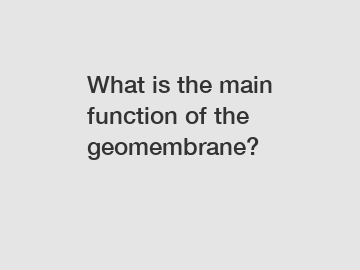What is the main function of the geomembrane?
Geomembranes may be one of the unsung heroes of the engineering and construction world, silently protecting and enhancing various projects globally. While their importance often goes overlooked, these innovative synthetic membranes have truly become indispensable in providing durable and flexible barrier solutions. In this blog, we delve into the main functions of geomembranes and explore their significance in different industries.
Section 1: Defining Geomembranes.
Geomembranes, also known as synthetic or polymeric liners, are essentially impermeable membranes crafted from robust materials such as HDPE (high-density polyethylene), PVC (polyvinyl chloride), or EPDM (ethylene propylene diene terpolymer). These sheets come in varying thicknesses, enabling engineers to select the appropriate geomembrane for each specific application.

Section 2: Environmental Protection.
One of the prime functions of geomembranes lies in their ability to provide effective environmental protection. Installed as liners in landfills, geomembranes act as a barrier, preventing contaminants from seeping into the underlying soil and groundwater. This protective function ensures that pollutants are contained, safeguarding ecosystems and human health.
In addition to landfills, geomembranes play a crucial role in preventing leakage from hazardous waste storage facilities, tailings dams, and industrial ponds. By acting as a robust and reliable containment solution, they help mitigate the potential risks associated with toxic materials.
Section 3: Water Resources Management.
Managing water resources is a complex challenge, especially when it comes to addressing leakage issues in storage reservoirs, canals, and aqueducts. Geomembranes offer a valuable solution for tackling this problem. Used as liners in such structures, they prevent water loss through seepage, ensuring maximum water availability and reducing the strain on natural water sources.
Moreover, geomembranes can be employed in wastewater treatment systems to prevent groundwater contamination. Their resistance to chemicals and UV radiation makes them excellent candidates for lining chemical storage ponds, effluent retention basins, and other industrial wastewater containment applications.
Section 4: Geotechnical Engineering.
Geomembranes play a pivotal role in geotechnical engineering projects by providing enhanced stability and soil reinforcement. In applications such as canals, reservoirs, and landfill capping, they act as a barrier between the soil and the surrounding environment. This separation facilitates controlled water flow, prevents soil erosion, and ensures long-term structural stability.
Section 5: Civil Construction and Infrastructure.
Geomembranes are increasingly utilized in civil construction projects to provide critical waterproofing solutions. From below-grade foundations to tunnels and roofing systems, these membranes offer exceptional durability and resistance against moisture, chemicals, and weathering. Their ability to withstand extreme climatic conditions contributes to the longevity and reliability of infrastructure projects.
Section 6: Creative Applications of Geomembranes.
Beyond their traditional functions, geomembranes also find innovative applications in a range of sectors. For instance, in agriculture, they are utilized as lining materials in irrigation channels and ponds for efficient water distribution. Geomembranes are also used in the energy sector, protecting containment areas for oil and gas exploration and geothermal energy projects.
Conclusion:
From environmental protection to water resource management, geotechnical engineering, and infrastructure construction, geomembranes possess a versatile range of functions. Their widespread usage across diverse industries underscores their importance in safeguarding the environment, enhancing structural integrity, and ensuring sustainable development.
As we continue to recognize and appreciate the manifold benefits of geomembranes, their use will only grow, pushing innovation further and contributing to the advancement of modern engineering solutions. With their qualities of durability, resilience, and adaptability, geomembranes will remain a steadfast presence, reinforcing our commitment to a safer and more sustainable future.
Are you interested in learning more about geomembrane vs geotextile, geotube manufacturer, geotextile membrane? Contact us today to secure an expert consultation!


